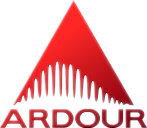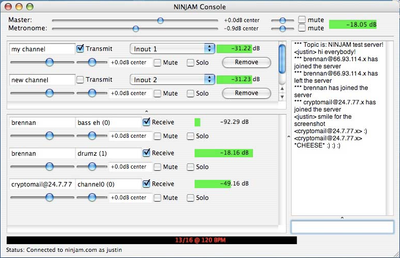
Justin Frankel is an American computer programmer best known for his work on the Winamp media player application and for inventing the Gnutella peer-to-peer network. Frankel is also the founder of Cockos Incorporated, which creates music production and development software such as the REAPER digital audio workstation, the NINJAM collaborative music tool and the Jesusonic expandable effects processor.

Ardour is a hard disk recorder and digital audio workstation application that runs on Linux, macOS, FreeBSD and Microsoft Windows. Its primary author is Paul Davis, who was also responsible for the JACK Audio Connection Kit. It is intended as a digital audio workstation suitable for professional use.
Independent Computing Architecture (ICA) is a proprietary protocol for an application server system, designed by Citrix Systems. The protocol lays down a specification for passing data between servers and clients, but is not bound to any one platform. Citrix's ICA is an alternative to Microsoft's Remote Desktop Protocol (RDP).

Server Message Block (SMB) is a communication protocol used to share files, printers, serial ports, and miscellaneous communications between nodes on a network. On Microsoft Windows, the SMB implementation consists of two vaguely named Windows services: "Server" and "Workstation". It uses NTLM or Kerberos protocols for user authentication. It also provides an authenticated inter-process communication (IPC) mechanism.

Virtual Studio Technology (VST) is an audio plug-in software interface that integrates software synthesizers and effects units into digital audio workstations. VST and similar technologies use digital signal processing to simulate traditional recording studio hardware in software. Thousands of plugins exist, both commercial and freeware, and many audio applications support VST under license from its creator, Steinberg.
TightVNC is a free and open-source remote desktop software server and client application for Linux and Windows. A server for macOS is available under a commercial source code license only, without SDK or binary version provided. Constantin Kaplinsky developed TightVNC, using and extending the RFB protocol of Virtual Network Computing (VNC) to allow end-users to control another computer's screen remotely.

Audio Stream Input/Output (ASIO) is a computer audio interface driver protocol for digital audio specified by Steinberg, providing high data throughput, synchronization, and low latency between a software application and a computer's audio interface or sound card.
Linux Terminal Server Project (LTSP) is a free and open-source terminal server for Linux that allows many people to simultaneously use the same computer. Applications run on the server with a terminal known as a thin client handling input and output. Generally, terminals are low-powered, lack a hard disk and are quieter and more reliable than desktop computers because they do not have any moving parts.

A diskless node is a workstation or personal computer without disk drives, which employs network booting to load its operating system from a server.
NX technology, commonly known as NX or NoMachine, is a remote access and remote control computer software allowing remote desktop access and maintenance of computers. It is developed by the Luxembourg-based company NoMachine S.à r.l. NoMachine is proprietary software and is free-of-charge for non-commercial use.
Music Player Daemon (MPD) is a free and open source music player server. It plays audio files, organizes playlists and maintains a music database. In order to interact with it, a client program is needed. The MPD distribution includes mpc, a simple command line client.
Real-Time Messaging Protocol (RTMP) is a communication protocol for streaming audio, video, and data over the Internet. Originally developed as a proprietary protocol by Macromedia for streaming between Flash Player and the Flash Communication Server, Adobe has released an incomplete version of the specification of the protocol for public use.
This page is a comparison of notable remote desktop software available for various platforms.
Adaptive Internet Protocol (AIP) is a multi-channel protocol that allows an application running on any of multiple platforms to be displayed on any of a wide range of client systems. It supports rich remote display and input services with a number of display options to deliver the presentation of the remote applications onto the local display either as a standalone window, or within a contained remote environment delivered full-screen or in a standalone window. The protocol also supports audio, printing, and other device mapping services.

Tonido was remote access and home server software for network-attached storage. It closed down operations in 2022.

Style Jukebox was a hi-fi high-resolution audio cloud music streaming and storage player for the Windows, iOS, Android and Windows Phone platforms. A Web Player was also available for Mac, Windows and Linux.
QVD is an open-source virtual desktop infrastructure (VDI) product built on Linux. Its main purpose is to provide remote desktops to users.

Opus is a lossy audio coding format developed by the Xiph.Org Foundation and standardized by the Internet Engineering Task Force, designed to efficiently code speech and general audio in a single format, while remaining low-latency enough for real-time interactive communication and low-complexity enough for low-end embedded processors. Opus replaces both Vorbis and Speex for new applications, and several blind listening tests have ranked it higher-quality than any other standard audio format at any given bitrate until transparency is reached, including MP3, AAC, and HE-AAC.

Jamulus is open source (GPL) networked music performance software that enables live rehearsing, jamming and performing with musicians located anywhere on the internet. Jamulus is written by Volker Fischer and contributors using C++. The Software is based on the Qt framework and uses the OPUS audio codec. It was known as "llcon" until 2013.
When playing music remotely, musicians must reduce or eliminate the issue of audio latency in order to play in time together. While standard web conferencing software is designed to facilitate remote audio and video communication, it has too much latency for live musical performance. Connection-oriented Internet protocols subject audio signals to delays and other interference which presents a problem for keeping latency low enough for musicians to play together remotely.









